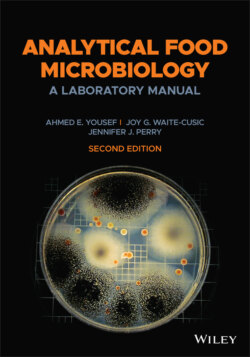Читать книгу Analytical Food Microbiology - Ahmed E. Yousef - Страница 64
Plates with greater than 200 colonies
ОглавлениеIf the plating procedure yields only plates with greater than 200 colonies, obtain an estimated count as follows. Count colonies in representative portions (determined subjectively) of the plate receiving the highest dilution. Using a lighted colony counter with gridlines that are 1‐cm apart (Figure 3.2) assists in choosing a representative area of the plate to count.
If there are fewer than 10 colonies per cm2, then count 13 squares chosen as follows: 7 consecutive horizontally and 6 consecutive vertically; see Figure 3.3 for a visual example of plate counting field. The sum of the colonies in the 13 squares multiplied by 5 equals the estimated count per 65 cm2 plate, which is the area of a typical Petri dish, assuming its inner diameter is ~90 mm.TABLE 3.1 Microbial population count in cooked meat.Dilution FactorNumber of ColoniesPlate 1 Plate 2 10–2 {least dilute}12 16 10–33 1 10–4 {most dilute}0 0 Figure 3.3 Procedure to estimate microbial population count in samples using crowded plates (> 200 colonies/plate).
If the number of colonies per cm2 are from 10 up to 100 colonies, count colonies in 4 representative squares and multiply the average by 65 to give estimated count per plate (Figure 3.3).
If there are greater than 100 colonies per cm2, then record the count as > 6500 CFU/plate (Figure 3.3).
In all cases, equation 3.7 is used to estimate population counts (CFU/g, est.). Never report the final count in the food sample as too numerous to count (TNTC). Plates with different surface areas, such as Petrifilms, are counted using the same principle. Count a minimum of 4 squares and average those counts, then multiply that count by the area of the plate being used.
